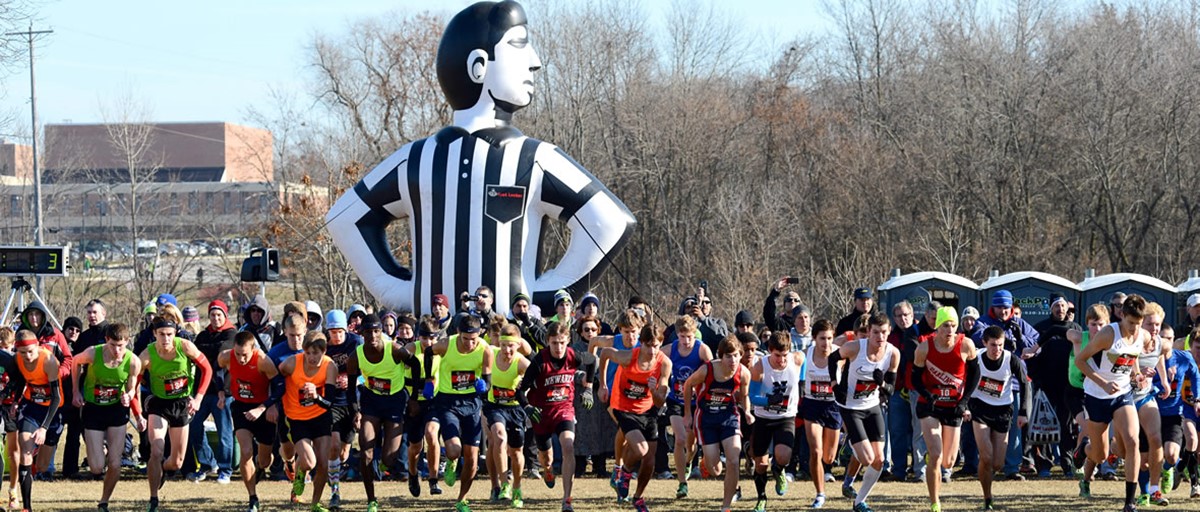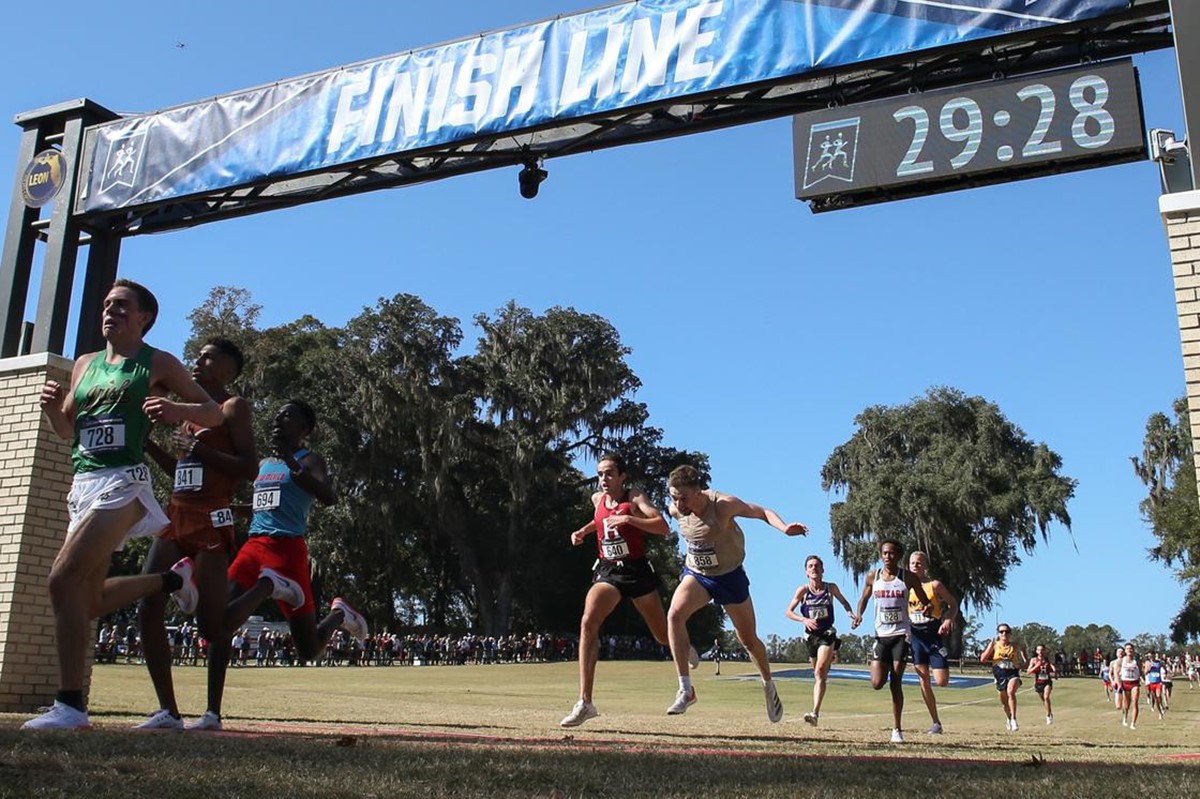Home>Misc>Featured>How To Train For Cross Country High School


Featured
How To Train For Cross Country High School
Modified: August 22, 2023
Learn how to train for cross country in high school with our featured tips and strategies to improve your performance and achieve your running goals.
Introduction
Welcome to the world of cross country running in high school! Whether you’re a beginner or a seasoned runner, this sport offers a unique blend of physical endurance, mental fortitude, and camaraderie. In this article, we will explore the exciting realm of cross country training, covering everything you need to know to excel in this demanding sport.
Cross country running is a popular sport in many high schools, attracting athletes who relish the challenge of long-distance running through varied terrains. It requires a combination of aerobic fitness, speed, agility, and mental toughness to conquer the distances and obstacles encountered during races.
Participating in cross country can provide numerous benefits. From improving cardiovascular health and building endurance to developing mental resilience and discipline, this sport offers a well-rounded athletic experience. Additionally, cross country fosters a sense of teamwork and camaraderie among teammates, as they train together, overcome challenges, and celebrate victories as a collective.
Before we delve into the nitty-gritty of cross country training, it’s important to note that every athlete is unique. Thus, it’s vital to tailor your training approach to your individual strengths, weaknesses, and goals. Whether you aim to improve your personal best time or wish to contribute to your team’s success, understanding the fundamentals of cross country training will set you on the right path.
In the following sections, we will explore the importance of cross country training in high school, setting goals for your training, creating a training plan, essential exercises, incorporating strength training, proper nutrition, injury prevention and recovery techniques, mental preparation, and racing strategies. By the end of this article, you will be equipped with the knowledge and tools to train effectively and reach your full potential as a cross country runner.
Importance of Cross Country Training in High School
Cross country training in high school is not just about running from point A to point B. It is a comprehensive program that plays a vital role in an athlete’s development, both physically and mentally. Let’s explore why cross country training is so important for high school runners.
First and foremost, cross country training is an excellent way to build endurance. Long-distance running requires athletes to have the stamina to sustain a fast pace over a significant distance. By consistently training and pushing their limits in practice, runners gradually increase their cardiovascular fitness, enabling them to go the distance during races.
Moreover, cross country training helps improve overall fitness levels. The intense aerobic activity involved in running long distances improves lung capacity, strengthens the heart, and boosts metabolism. These physical benefits not only enhance performance on the cross country course but also contribute to an overall healthier lifestyle.
Aside from the physical gains, cross country training also strengthens mental resilience. Distance running requires mental toughness as athletes must overcome fatigue, push through pain, and maintain focus for an extended period. By persevering through challenging workouts and races, high school runners develop mental fortitude that extends beyond the field, helping them tackle obstacles in various aspects of life.
Participating in cross country training also fosters a sense of camaraderie and teamwork. Runners train together, support each other, and learn the value of working towards a common goal. The shared experiences, hardships, and triumphs on the cross country course create a bond among teammates that can last a lifetime.
Furthermore, cross country training promotes discipline and goal-setting. To excel in this sport, athletes must commit to a regular training routine, maintain a healthy lifestyle, and prioritize their goals. Setting specific, achievable targets provides runners with a sense of purpose, motivation, and direction.
Lastly, cross country training offers a unique opportunity for personal growth and self-discovery. High school runners often surprise themselves by surpassing their own expectations and realizing their true potential. Through the highs and lows of training and racing, athletes learn valuable lessons about resilience, determination, and self-belief.
Overall, cross country training in high school is more than just physical conditioning. It is a transformative experience that helps athletes develop endurance, mental toughness, teamwork, discipline, and personal growth. The skills and qualities gained through cross country training extend far beyond the racecourse, benefiting young runners in all areas of their lives.
Setting Goals for Cross Country Training
Setting goals is a crucial aspect of cross country training in high school. Having clear and defined objectives allows athletes to focus their efforts, stay motivated, and track their progress throughout the season. Let’s explore how to effectively set goals for cross country training.
The first step in goal setting is to identify your individual aspirations as a runner. What do you want to achieve in cross country? Are you aiming to improve your personal best time, contribute to your team’s success, or make it to the state championships? Understanding your personal motivations will help you set meaningful and relevant goals.
Once you have a clear vision of your objectives, it’s important to make your goals specific and measurable. Rather than setting a vague goal like “get faster,” set a specific time goal, such as completing a 5k in under 20 minutes. This allows you to track your progress and assess whether you’re on track to achieve your goal.
In addition to specificity, goals should also be realistic and attainable. While it’s important to challenge yourself, setting unrealistic goals can lead to frustration and burnout. Consider your current fitness level, past performances, and the amount of time you have to train when setting your goals.
Alongside long-term goals, it’s beneficial to set short-term goals and milestones. These provide stepping stones and help you stay motivated along the way. For example, you might set a goal to consistently complete your training runs for the next two weeks without missing any sessions.
Another critical aspect of goal setting is accountability. Sharing your goals with your coach, teammates, or even friends and family can provide a sense of responsibility. Discussing your goals also allows others to support and encourage you along your journey.
It’s important to regularly assess and adjust your goals as needed. Throughout the training season, you may encounter setbacks or improvements that necessitate reevaluating your goals. Be flexible and adaptable, making changes to ensure your goals remain challenging yet attainable.
Finally, motivation plays a key role in goal achievement. Find ways to keep yourself inspired and motivated throughout the training process. Whether it’s visualizing success, creating a vision board, or seeking support from teammates, staying motivated can help you overcome challenges and persevere towards your goals.
In summary, setting goals for cross country training is essential for success. Be specific, measurable, realistic, and attainable in your goal setting. Create both long-term and short-term goals, share them with others for accountability, regularly assess and adjust your goals, and stay motivated throughout the process. By setting effective goals, you will streamline your efforts, stay focused, and maximize your potential as a cross country runner.
Creating a Training Plan
Having a well-designed training plan is essential for success in cross country running. It helps structure your workouts, ensures proper progression, and maximizes your performance potential. Let’s explore the key elements to consider when creating a training plan for cross country.
The first step in creating a training plan is to establish a base. This involves gradually increasing your mileage and building your endurance foundation. Start with shorter distances and gradually increase the duration and intensity of your runs over time. Incorporate a mix of easy runs, tempo runs, and long runs to develop your aerobic capacity.
Next, consider the importance of variety in your training plan. Incorporate different types of workouts to improve different aspects of your running performance. Integrate interval training to boost speed and anaerobic capacity. Include hill repeats to develop strength and power. Incorporate tempo runs to improve lactate threshold and race pace.
It’s crucial to balance hard workouts with recovery days. Rest and recovery are just as important as training itself. Schedule easy or rest days to allow your body to recover, repair, and adapt to the physical stresses of training. This will help prevent injuries and ensure optimal performance during key workouts and races.
Consistency is key in cross country training. Regular training is more effective than sporadic high-volume workouts. Establish a routine that works for you, considering your schedule, commitments, and recovery needs. Aim for three to six training sessions per week, depending on your fitness level and the specific phase of your training season.
Gradual progression is essential to avoid overtraining and injury. Gradually increase your overall weekly mileage, the intensity of your workouts, and the duration of your long runs. But remember, progression should be gradual and individualized, taking into account your fitness level, injury history, and recovery capacity.
Listen to your body throughout your training plan. Recognize the signs of fatigue, overtraining, or potential injury. If you feel excessively worn out or experience persistent pain, adjust your training accordingly. It’s better to take a step back and prioritize recovery than to push through and risk worsening the situation.
Flexibility is also key in a training plan. Life happens, and unexpected events may disrupt your training schedule. Be prepared to make adjustments as needed. Modify workouts, shuffle rest days, or rearrange training sessions to work around unforeseen circumstances, just as long as you maintain the fundamental structure of your plan.
Lastly, keep a training log to track your progress, workouts, and any relevant notes. This will help you monitor your improvement, identify patterns, and make informed decisions about adjusting your training plan as needed.
In summary, creating a training plan for cross country involves establishing a base, incorporating variety, balancing hard workouts with recovery, maintaining consistency, gradually progressing, listening to your body, being flexible, and keeping a training log. By designing a well-structured plan, you will optimize your training efforts, improve your performance, and achieve your cross country goals.
Essential Cross Country Training Exercises
To excel in cross country running, it’s important to incorporate a variety of exercises into your training regimen. These exercises target key muscle groups, improve running form, and enhance overall performance. Let’s explore some essential cross country training exercises.
1. Plyometric Exercises: Plyometric exercises, such as box jumps and squat jumps, help improve explosive power and leg strength. These exercises engage fast-twitch muscle fibers, enhancing your ability to generate force and propel yourself forward during races.
2. Hill Repeats: Running uphill is an excellent way to strengthen your leg muscles and improve your endurance. Incorporate hill repeats into your training routine, sprinting up hills and recovering on the downhill or flat sections. This exercise simulates the demands of hilly cross country courses.
3. Interval Training: Interval training involves alternating between periods of high-intensity effort and active recovery. This type of training boosts your anaerobic capacity, speed, and race pace. Examples include alternating between sprinting and jogging, or running at race pace for specific distances.
4. Strength Training: Strength training is essential for injury prevention and improving overall performance. Focus on exercises that target your lower body, such as squats, lunges, and calf raises. Additionally, incorporate exercises for your core and upper body, such as planks, push-ups, and rows, to enhance stability and maintain proper posture while running.
5. Running Drills: Running drills can improve your running form, efficiency, and stride length. Incorporate exercises like high knees, butt kicks, and A-skips into your warm-up routine. These drills help activate the muscles used in running and promote proper mechanics.
6. Long Runs: Long runs are the cornerstone of cross country training. These runs help build endurance, mental toughness, and simulate the demands of race day. Aim for a weekly long run that gradually increases in duration, challenging your body to adapt to longer distances.
7. Tempo Runs: Tempo runs involve running at a comfortably hard pace just below your lactate threshold. These runs improve your body’s ability to clear lactic acid and sustain a faster pace for longer periods. Incorporate a weekly tempo run into your training to improve your race pace and endurance.
8. Cross-Training: While running is the primary focus of cross country training, incorporating cross-training activities can provide additional benefits. Activities such as cycling, swimming, or using an elliptical machine offer low-impact cardiovascular workouts that complement your running training while reducing the risk of overuse injuries.
Remember, proper form and technique are essential in all exercises to avoid injury and optimize their benefits. If you’re unsure about proper form, consider working with a coach or seeking guidance from experienced runners.
Incorporating these essential cross country training exercises into your routine will help you build strength, power, endurance, and improve your overall running performance. By targeting the specific demands of cross country running, you’ll be well-prepared to tackle any course and achieve your race day goals.
Incorporating Strength Training
In addition to running, incorporating strength training into your cross country training program is crucial for enhancing performance, reducing the risk of injury, and improving overall strength and stability. Let’s explore the importance of strength training and how to incorporate it effectively into your routine.
Strength training exercises target muscle groups that are often neglected in running but play a crucial role in maintaining proper form and preventing imbalances. By strengthening your muscles, tendons, and ligaments, you can improve your running economy and reduce the risk of injury.
Focus on exercises that target your lower body, such as squats, lunges, and calf raises. These exercises strengthen your quadriceps, hamstrings, glutes, and calves, which are vital for generating power and stabilizing your hips and knees during runs.
Incorporating exercises for your core is also essential. A strong core improves stability and helps maintain good posture, reducing the likelihood of developing poor running form or lower back pain. Planks, Russian twists, and bicycle crunches are effective exercises to strengthen your core.
Furthermore, don’t neglect your upper body. Although running primarily uses the lower body, having a strong upper body can improve arm swing, balance, and overall posture while running. Incorporate exercises like push-ups, pull-ups, and shoulder presses to strengthen your upper body muscles.
When incorporating strength training into your cross country training program, aim for two to three sessions per week. Focus on compound exercises that work multiple muscle groups simultaneously, rather than isolated exercises. This approach will maximize efficiency and help promote functional strength.
Consider performing strength training exercises on non-running days or after an easy run to ensure your muscles are warm and ready. Be sure to allow for adequate rest and recovery between strength training sessions to avoid overworking your muscles and risking injury.
If you’re new to strength training, start with lighter weights or bodyweight exercises and gradually increase the intensity as you progress. Form and technique should always take precedence over the amount of weight lifted.
As you gain strength and adapt to the exercises, progressively increase the resistance or difficulty level. This can be achieved by increasing repetitions, sets, or weight, but remember to do so gradually to avoid excessive strain.
Finally, consider working with a qualified strength training coach or seeking guidance from experienced runners to ensure you are performing exercises correctly and to tailor your strength training program to your specific needs and goals.
Incorporating strength training into your cross country training program is a valuable investment in your performance and overall health. By targeting specific muscle groups, strengthening your core and upper body, and maintaining proper form, you’ll become a stronger, more resilient runner, ready to take on the challenges of cross country running.
Proper Nutrition for Cross Country Runners
Nutrition plays a significant role in the performance, energy levels, and overall health of cross country runners. A well-balanced and nutrient-dense diet helps fuel training, boosts recovery, and optimizes performance on race day. Let’s explore the key elements of proper nutrition for cross country runners.
First and foremost, adequate energy intake is crucial for cross country runners, considering the high calorie expenditure during training and competition. Aim to consume a balanced diet that provides enough calories to meet your energy needs. This may involve increasing your overall food intake, particularly from carbohydrates, which are the primary fuel source for endurance activities.
Carbohydrates are essential in maintaining glycogen stores, which fuel your muscles during long-distance runs. Prioritize complex carbohydrates, such as whole grains, fruits, vegetables, and legumes, as they provide a steady release of energy and contain essential nutrients and fiber.
Protein is also crucial for cross country runners, as it supports muscle recovery and repair. Include lean sources of protein in your diet, such as chicken, fish, lean meats, beans, lentils, tofu, and low-fat dairy products. Aim for an adequate protein intake to support your training and aid in muscle development and repair.
Healthy fats are another important component of a balanced diet for cross country runners. Incorporate sources of unsaturated fats, such as avocados, nuts, seeds, and olive oil. These fats provide essential fatty acids, which support overall health and can help reduce inflammation in the body.
Hydration plays a critical role in performance and recovery for cross country runners. Proper hydration ensures optimal muscle function, temperature regulation, and overall well-being. Drink water regularly throughout the day and monitor your fluid intake, increasing it during strenuous workouts and hot weather conditions.
Timing is key when it comes to nutrition for cross country runners. Aim to have a pre-run meal or snack that combines carbohydrates and a small amount of protein about 2-3 hours before your training session or race. This provides the necessary fuel and prevents stomach discomfort. Additionally, refuel within 30-60 minutes after your workout with a snack or meal containing carbohydrates and protein to promote muscle recovery and replenish glycogen stores.
Individual preferences and tolerance should guide your nutritional choices. Experiment with different foods during training to determine what works best for your body. It’s advisable to consult with a registered dietitian to develop a personalized plan and address any specific dietary needs or concerns.
Lastly, don’t forget the importance of overall health and well-being. A balanced diet should be accompanied by a focus on whole, nutrient-dense foods while limiting processed and sugary foods. Adequate sleep, stress management, and a healthy lifestyle also contribute to overall performance and recovery.
In summary, proper nutrition for cross country runners entails consuming a well-balanced diet that provides adequate energy, carbohydrates, protein, and healthy fats. Stay hydrated, time your meals and snacks appropriately, listen to your body’s needs, and prioritize overall health and well-being. With proper nutrition, you’ll optimize your training, recovery, and performance on the cross country course.
Injury Prevention and Recovery Techniques
In any sport, including cross country running, injury prevention and recovery are essential for maintaining optimal performance and long-term participation. The repetitive nature of running can put strain on the body, making it crucial to incorporate injury prevention strategies and recovery techniques. Let’s explore some key approaches to keep you injury-free and support your recovery as a cross country runner.
1. Warm-Up and Cool-Down: Prior to each training session or race, warm up adequately to prepare your muscles and joints for the demands of running. A dynamic warm-up that includes mobility exercises and light jogging helps increase blood flow and flexibility. Afterwards, cool down with light jogging and static stretching to aid in the removal of waste products and reduce muscle soreness.
2. Strength Training and Cross-Training: Strengthening your muscles, tendons, and ligaments through exercises targeting the entire body can help prevent overuse injuries. Incorporate strength training exercises at least twice a week, focusing on key areas such as the core, lower body, and hip stabilizers. Additionally, consider incorporating cross-training activities, such as swimming or cycling, to reduce impact and give your body a break from the repetitive stress of running.
3. Proper Footwear: Wearing appropriate running shoes that provide adequate support, cushioning, and stability is crucial for injury prevention. Invest in a pair of shoes specifically designed for your foot type, running gait, and the terrain you will be running on. Replace your shoes regularly to ensure they maintain their cushioning and support.
4. Gradual Progression: Avoid sudden increases in mileage or intensity, as this can lead to overuse injuries. Gradually increase your training volume and intensity to allow your body to adapt and build strength gradually. Listen to your body and take rest days or modify your training if you experience pain or discomfort.
5. Recovery Techniques: Proper recovery is essential for preventing injuries and optimizing performance. Include rest days in your training schedule to allow for muscle repair and adaptations. Additionally, incorporate recovery techniques such as foam rolling, stretching, massage, and icing to alleviate muscle soreness and reduce inflammation.
6. Listen to Your Body: Pay attention to any signs of pain, discomfort, or changes in your body. If you experience persistent pain or notice any warning signs of injury, such as swelling or limited range of motion, seek professional guidance from a sports medicine specialist or physical therapist. They can provide a proper diagnosis and develop a targeted treatment plan.
7. Nutrition and Hydration: Proper nutrition and hydration play a vital role in injury prevention and recovery. Ensure you are fueling your body with a balanced diet that provides essential nutrients for tissue repair and rebuilding. Stay hydrated throughout the day and during training sessions to maintain optimal performance and aid in recovery.
Remember, prevention is always better than treatment when it comes to injuries. By incorporating these injury prevention strategies and recovery techniques into your cross country training, you’ll reduce the risk of injuries, enhance your performance, and enjoy the sport for years to come.
Mental Preparation for Cross Country Racing
While physical training is essential for cross country runners, mental preparation is equally as important. Developing mental resilience, focus, and confidence can greatly enhance your performance during races. Let’s explore some key strategies for effective mental preparation in cross country racing.
1. Set Clear Goals: Start by setting clear and specific goals for your races. Whether it’s achieving a personal best time, placing in the top ten, or successfully executing a specific race strategy, having a clear objective helps drive your focus and motivation during training and competition.
2. Visualize Success: Use visualization techniques to imagine yourself running strong, maintaining a steady pace, and crossing the finish line. Create mental images of successfully overcoming obstacles, such as challenging terrains or competitors. Visualizing success helps build confidence and reinforces positive outcomes.
3. Develop Race-Day Strategies: Create race-day strategies that encompass pacing, tactics, and mental cues. Develop a plan for different scenarios, such as starting conservatively, maintaining a steady pace, and strategic surges or kicks during the race. Having a well-thought-out strategy provides a roadmap and boosts confidence.
4. Positive Self-Talk: Monitor your internal dialogue and replace any negative or self-doubting thoughts with positive and encouraging ones. Use affirmations and self-motivating statements to boost your confidence. Remind yourself of your training, preparation, and past successes to build a positive mindset.
5. Focus on Process, Not Outcome: Instead of solely focusing on the end result or outcome, divert your attention to the process and the present moment. Concentrate on your form, breathing, and maintaining a steady rhythm. Breaking the race into smaller segments or landmarks can also help maintain focus.
6. Embrace Discomfort: Cross country racing can be physically and mentally challenging. Embrace the discomfort and accept that it is a natural part of the sport. Develop strategies to manage discomfort, such as deep breathing, mental distractions, or positive mantras, to push through difficult moments during the race.
7. Practice Mindfulness and Relaxation Techniques: Incorporate mindfulness and relaxation techniques into your training routine to cultivate a calm and focused mind. Techniques such as deep breathing exercises, meditation, and progressive muscle relaxation can help reduce pre-race jitters and promote a state of mental relaxation.
8. Learn from Setbacks: It’s important to view setbacks or disappointing races as learning experiences rather than failures. Reflect on what went wrong, identify areas for improvement, and use those experiences to fuel your motivation for future races.
9. Adequate Rest and Recovery: Give yourself adequate rest and recovery time between races to avoid mental burnout. Allow yourself downtime and engage in activities that rejuvenate your mind and help you relax.
Remember, mental preparation is a continuous process that should be integrated into your training routine. By implementing these strategies, you can develop the mental resilience, focus, and confidence needed to perform at your best during cross country races.
Cross Country Racing Strategies
Cross country racing requires a combination of physical endurance, mental strength, and strategic decision-making. Developing effective racing strategies can help you navigate the varying terrains, make tactical moves, and achieve your best performance. Let’s explore some key strategies to consider for cross country racing.
1. Start Strong, but Controlled: The start of a cross country race is often fast-paced and crowded. Position yourself near the front of the pack to avoid getting caught in congestion. However, be mindful of starting too aggressively, as it may lead to early fatigue. Find a balance between a strong start and conserving energy for the rest of the race.
2. Study the Course: Familiarize yourself with the course before race day. Look for challenging sections, such as hills, sharp turns, or uneven terrain. Identify areas where you can make strategic moves, such as using inclines to surge ahead or taking advantage of flat stretches to increase your pace.
3. Pace Yourself: Cross country races are typically long-distance endeavors, and pacing is crucial for maintaining a consistent effort throughout the race. Avoid going out too fast in the initial stages and focus on running at a sustainable pace. Gradually increase your effort as the race progresses, using surges strategically to overtake competitors when appropriate.
4. Assess the Competition: Observe your competitors’ strengths and weaknesses during the race. Pay attention to their race strategies, running form, and energy levels. Use this information to your advantage by making tactical decisions, such as accelerating to pass a struggling runner or staying close to a strong competitor who sets a consistent pace.
5. Make Efficient Turns: Take the shortest and most efficient lines around turns. This involves hugging the inside of curves and not veering off the course unnecessarily. By minimizing extra distance, you can maintain momentum and conserve energy.
6. Use the Power of Surges: Well-timed surges can be an effective tactic during a cross country race. Choose your moments to accelerate and break away from competitors, particularly during uphill sections, downhills, or when you sense weakness in others. However, be mindful of your energy reserves and use surges strategically rather than constantly sprinting and exhausting yourself.
7. Mental Toughness and Visualization: Maintain a strong mental mindset throughout the race. Stay focused, positive, and determined, particularly during challenging sections. Use visualization techniques to imagine yourself pushing through difficult moments and visualizing a successful finish.
8. Finish Strong: As you approach the final stretch of the race, give it your all. Dig deep and find that extra burst of energy, sprinting towards the finish line. Remember, many races are won or lost in the final moments, so maintaining mental and physical strength is crucial.
9. Learn from Each Race: After each race, reflect on your performance. Identify what worked well and areas for improvement. Analyze your pacing, strategy, and execution. Use this insight to adjust and refine your racing strategies for future races.
Remember, racing strategies can vary depending on course conditions, competition dynamics, and personal strengths. Experiment with different approaches during training and adapt your strategies based on your experiences. By developing effective racing strategies, you can optimize your performance and achieve your goals in cross country racing.
Conclusion
Cross country running in high school is a challenging and rewarding sport that demands physical endurance, mental fortitude, and strategic thinking. By incorporating the right training, setting clear goals, and adopting effective strategies, you can excel in this sport and reach your full potential. It’s important to remember that cross country training is not just about running—it is a holistic approach that encompasses various aspects, from physical conditioning to mental preparation and nutrition.
In this article, we explored the importance of cross country training in high school and how it contributes to overall athletic development. We discussed the significance of setting goals, creating a training plan, and incorporating essential cross country training exercises. We also touched on the importance of strength training, proper nutrition, injury prevention, recovery techniques, and mental preparation.
Proper training and conditioning, combined with mental resilience, play a vital role in cross country racing success. By implementing strategies such as visualizing success, using effective race-day tactics, and maintaining a positive mindset, you can overcome challenges and achieve your goals on the racecourse.
Remember, cross country running is not just a physical challenge—it is also a journey of self-discovery, teamwork, and personal growth. Embrace the process, learn from setbacks, and celebrate your achievements along the way.
Now, armed with the knowledge and insights shared in this article, you are well-equipped to embark on your cross country journey. Train diligently, listen to your body, stay motivated, and visualize your success. With dedication and perseverance, you have the ability to thrive in the exhilarating world of high school cross country running.









